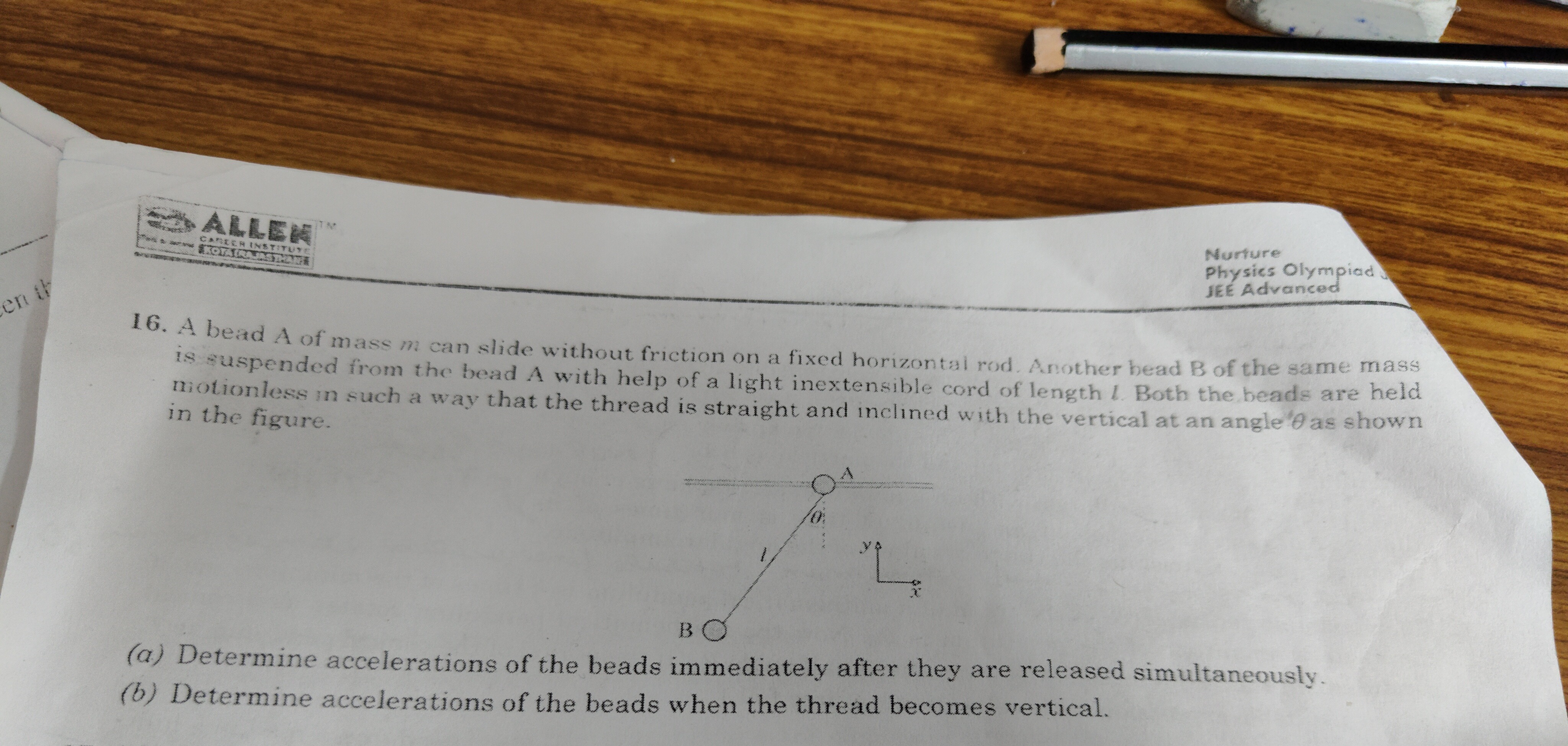Question
Question: A bead A of mass $m$ can slide without friction on a fixed horizontal rod. Another bead B of the sam...
A bead A of mass m can slide without friction on a fixed horizontal rod. Another bead B of the same mass is suspended from the bead A with help of a light inextensible cord of length l. Both the beads are held motionless in such a way that the thread is straight and inclined with the vertical at an angle θ as shown in the figure.
(a) Determine accelerations of the beads immediately after they are released simultaneously.
(b) Determine accelerations of the beads when the thread becomes vertical.

a) aA=1+sin2θgsinθcosθi^,aB=−1+sin2θgsinθcosθi^−1+sin2θ2gsin2θj^;b)aA=0,aB=2g(1−cosθ)j^
Solution
Explanation of the solution:
Part (a): Immediately after release
- Free Body Diagrams and Newton's Laws:
- For bead A (mass m), moving horizontally: The horizontal component of tension Tsinθ causes its acceleration aA. So, Tsinθ=maA.
- For bead B (mass m):
- Horizontal motion: The horizontal component of tension −Tsinθ (opposite to A's acceleration) causes its horizontal acceleration aBx. So, −Tsinθ=maBx.
- Vertical motion: The vertical component of tension Tcosθ and gravity mg cause its vertical acceleration aBy. So, Tcosθ−mg=maBy.
- Conservation of Horizontal Momentum: Since there are no external horizontal forces, the horizontal momentum of the system (A+B) is conserved. As the system starts from rest, the total horizontal momentum remains zero. This implies maA+maBx=0, leading to aBx=−aA.
- Kinematic Constraint (Inextensible String): At the instant of release, velocities are zero. The acceleration of B relative to A, aB/A=aB−aA, must be perpendicular to the string (purely tangential, no centripetal component as v=0). The string is along the direction (sinθi^−cosθj^) relative to A. Therefore, the dot product of aB/A with this direction must be zero: (aBx−aA)sinθ−aBycosθ=0.
- Solving the System: Substitute aBx=−aA into the kinematic constraint to get aBy=−2aAtanθ. Then, substitute T=maA/sinθ (from A's equation) and the expression for aBy into B's vertical equation. This allows solving for aA. Once aA is found, aBx and aBy are determined.
Part (b): When the thread becomes vertical
- Velocities (Conservation of Energy and Momentum):
- Horizontal momentum conservation still holds: mvA+mvBx=0⟹vBx=−vA.
- When the string is vertical, bead B is directly below bead A. The velocity of B relative to A, vB/A, must be along the vertical string. This implies vBx−vA=0, so vBx=vA.
- Combining these, vA=vBx=0. This means the horizontal velocities of both beads are zero when the string is vertical.
- Conservation of mechanical energy: The initial potential energy is −mglcosθ (taking the rod as y=0). The final potential energy is −mgl. The final kinetic energy is 21mvA2+21mvB2. Since vA=0 and vB is purely vertical (vB=vBy), the final kinetic energy is 21mvBy2. Equating initial and final energies gives 21mvBy2=mgl(1−cosθ), so vBy2=2gl(1−cosθ).
- Accelerations:
- For bead A: Tsin(0)=maA⟹aA=0.
- For bead B:
- Horizontal: −Tsin(0)=maBx⟹aBx=0.
- Vertical: Tcos(0)−mg=maBy⟹T−mg=maBy.
- Kinematic Constraint (Acceleration): When the string is vertical, the acceleration of B relative to A is purely centripetal, directed upwards along the string. So, aB/A,y=vBy2/l.
- Since aA=0, aBy=vBy2/l. Substitute the value of vBy2 to get aBy=2g(1−cosθ).
Answer:
The accelerations of the beads are: (a) Immediately after they are released simultaneously:
- Acceleration of bead A: aA=1+sin2θgsinθcosθi^
- Acceleration of bead B: aB=−1+sin2θgsinθcosθi^−1+sin2θ2gsin2θj^
(b) When the thread becomes vertical:
- Acceleration of bead A: aA=0
- Acceleration of bead B: aB=2g(1−cosθ)j^
